
Brittany Articles Written by NVBC Members to Inform and Educate |
|||||
|---|---|---|---|---|---|
| Agility | Barn Hunt | Field Trials | Grooming | Hunt Tests | Obedience |
Agility Competition 101article by Judi Parker, NVBC |
|||||
If you are new to the world of agility competition you may feel as if you are an alien being who has just landed on this big field in the warm summer time. In this field are all these bizarre looking objects. There is a triangle, a circle, a flat surface, lots of poles held off the ground by other poles, a couple of bright colored tubes, a set of six or more sticks coming out of the ground, a long board sitting on a balance beam, and this other thing that looks like a long plank with ramps at each end. Now if this not confusing enough, make if more confusing by adding about 25 human beings wandering around all this stuff. And they are not just walking, they are WEIRD. They are jogging, bending, twisting, waiving their hands and silently mouthing words you cannot begin to understand: "out", "here", "weave", "over", "walk it", "scramble", "climb", "jump it", "tunnel", "switch", "teeter", and "table". Then, as if by magic, the field clears and one lone person moves to the center of all this stuff and proclaims that she is "ready". Ready for what? Then, lo and behold, the first four legged creature is brought on the field . . . . Welcome to an agility trial and one of the most memorable experiences you and your dog may ever have on earth. In the summer of 2000 I was feeling a bit like that alien. My Brittany, Dickens, was competing in agility and she has been allowing me to come along as her cheering section. I felt like I was learning a foreign language. I now know what all that stuff is, what all the words mean, and I know my dog loves it. Introduction to Agility Trials
Agility Levels There are three levels in agility. Novice, for beginners, Open and Elite. There are also jumpers' courses that are basically jumps and tunnels or jumps and weave poles and, once again, the difficulty of the course is determined by the level at which your dog is competing. The idea is to get your dog around the course in its proper order and under the allotted time. This is where the poetry or the embarrassment comes into play. Pretty straight forward, right?
There are three levels in agility. Novice, for beginners, Open and Elite. There are also jumpers' courses that are basically jumps and tunnels or jumps and weave poles and, once again, the difficulty of the course is determined by the level at which your dog is competing. The idea is to get your dog around the course in its proper order and under the allotted time. This is where the poetry or the embarrassment comes into play. Pretty straight forward, right?
Remember all those strange people walling around all that stuff? Well, that is called "walking the course" to familiarize yourself with the obstacles, the sequence, and the traps. Oh, did I forget to mention that there are some items on the field that are not part of the course. They are the traps! Use your imagination. Gamblers Agility Course And we have yet to discuss Gamblers, the course for those who wish to be creative or crazy depending on the day and the dog. This is agility for the strong of heart and fleet of foot. All the obstacles are out on the field in what I suspect is a random pattern. The "walk" will give any observer an idea of how interesting this is going to be. Many of the walkers are actually running and jogging, stop watches in hand. The object of this exercise is to gather points at the beginning of the run. If I'm correct, each team has 45 seconds to collect as many points as possible, jumps are worth 1 point, six weave poles are work 3 points, 12 are worth 6 points, all contact obstacles (e.g. ramps, tables) are worth 5 points, and tunnels are worth 3 points. The object is to get X number of points depending on your level (novice, open or elite) before the whistle blows and the gamble begins. Now let me tell you about the gamble. There is a tape or some kind of marker laid out on the ground and on one side of the tape are a certain number of articles, maybe a teeter, weave poles, a tunnel or two and jump or two. When the whistle blows, the handler and dog has 17 seconds to complete the articles on the other side of the tape. The problem here is two fold. While you are running the first part of the course collecting your required points, you have to have a mental stopwatch in your head because you want to be as close to that tape line as possible with the most points possible before the whistle blows. This is not an easy feat to accomplish. The second problem is that stupid tape marker. You can't cross over the line to run the gamble. Only your teammate (your Brittany that may make you look like a hero or idiot) can and must cross the line and do the obstacles working away form you and in 17 seconds no less! This is, to say the least, one of the most interesting of the agility classes no matter what kind of dog you are handling. You have to be able to laugh at yourself and allow others, including your dog, to laugh with and at you. Case in point is the handler whose timing was off and who ended up jumping the jump while his dog went around it. Go to an agility trial; bring a chair, a sun hat and sun screen. Park yourself and just watch. Maybe you will be lucky enough to watch a handler and dog have a run that is so beautiful and so in synch that it will take your breath away. Or you can enjoy the creative coursing that happens when dog and handler come unglued! Either way it is a day that you will not soon forget and I am pretty certain that when it is over you will be more that interested in finding a place to train so that you can be part of this lunacy and enjoy what may be the best time that you and your dog could possibly have together! For more information on agility: NVBC hosted Agility Matches scheduled for 2018. North American Dog Agility Council United States Dog Agility Association, Inc. - "Promoting international standards in dog agility." AKC Regulations for Agility Trials - Official rules and regulations from AKC with sample courses and obstacle construction. |
|||||
Introduction to Barn Hunt 101article by Tom Mauter, CNMBC, NVBC |
|||||
As the web master for two Brittany Clubs, Northern Virginia and Central New Mexico, I receive some interesting inquires and requests. One such request was to inform members of the Central New Mexico Brittany Club about upcoming training sessions in Barn Hunt. Barn what? I never heard of it but before I would entertain informing the club’s board members of this request, I needed more information. That was in late spring of 2014. Fast forward to this past weekend, I now have a new Barn Hunt title on Ollie, my Brittany – RATN (Novice)! Barn Hunt – the Beginning The founder, Robin Nuttall, was a frustrated Miniature Pinscher and Doberman owner. Her Min Pins were not allowed to compete in Earthdog competitions despite being excellent ratters. Shortly thereafter she discovered that several clubs held “above ground” barn hunts with dogs hunting rats. She entered her Min Pin and her Doberman in an event held by the Bluegrass (KY) Working Terrier Association. When her Dobe got a placement ribbon, the light bulb went off. Presto, a new sport was in the making. It was officially launched in 2013 and is now recognized by the AKC. Barn Hunt – the Basics Bales of straw or hay are stacked up, two, three, four bales tall depending on the level of competition (Novice, Open, Senor, Master.) There are tunnels, the number and shape are based on the level, which each dog must go through. Each dog is required to climb atop a bale with all four paws in contact. Finally, the dog must find a rat in a tube. The number of finds is, again, dependent upon the level of competition. Also, empty tubes and tubes with used rat litter are added to the mix for extra challenges. All tubes are hidden amidst the straw. The safety and well being of the rats are of utmost importance in this competition. Ready Go! All events have a qualifying time limit in which to correctly identify only the live rat(s) in a tube, complete the required tunnel(s) and execute a successful bale climb within two minutes to four and a half minutes, level specific. Qualifying placements, first through fourth place, are based on elapsed time. What’s in Barn Hunts for Brittanys? The purpose of Barn Hunt is to demonstrate a dog’s vermin hunting ability in finding and marking rats in a “barn-like” setting …inside or out. What Brittany doesn’t like to hunt? My Brittanys enjoys the hunt for game birds as well as gophers, mice and lizards which are much more plentiful than quail around our property in New Mexico. This sport seemed like a good match between obedience and fieldwork with a bit of agility thrown in for a good measure of fun. There is also and an advanced level of Barn Hunt competition involving teams of two dogs and two handlers, working together to hunt for rats. Important to pointing sporting breeds, honoring and backing are allowed. Teams are self-selected and not subject to a random draw of teammates. The going through the tunnel aspect was new for Ollie. It took all of seven minutes to train him to go through tunnels, both straight and angled with confidence. He climbed up on a bale on command, piece of kibble. Once he saw and scented the rat in the tube, he got it. Lots of positive reinforcement sealed the deal. Watching him work amidst the stacks of straw bales and locking on point rivaled, on some levels, the beauty of seeing him point birds in our greenbelt or in a bird-field at a Hunt Test. His ability to freeze in place on a hard point with the tube hidden by straw was an eye opener for a number of other competing handlers. Of course, most dogs in Barn Hunt events don’t point…but we forgive them. Does Ollie Enjoy Barn Hunt? He turned 10 in June, 2014 but his eagerness to get into the Barn Hunt area was intense. As the judge said, “he came in hunting.” My Brittany is huge and is the most built-for-comfort Brittany I have ever been around dating back to 1952. His three qualifying runs, earning his Novice title, were very pleasing but his placing second in all three runs was even more rewarding. Based on his time to complete the required activities, he was runner up on all three runs to an Australian Shepard named Vespa. Vespa! Added Bonus Barn Hunt titles, from Novice up, are now recognized by AKC. Moreover, it can be a way to expand club membership and members’ involvement with Brittany club activities. More Information This sport is growing. Demonstrations clinics and fun trials are popping-up across the nation as are full trials, many of which offer four trials at a single site over a weekend. Look for Yourself YouTube has an array of videos with dogs participating in Barn Hunt events including introduction to the sport. This is video of a Brittany competing in the Novice level. Official Barn Hunt Rules, adopted June 1, 2019 |
|||||
Introduction to Field Trials 101article by Bob and Joann Anders, NVBCPortions of this article are excerpted from The Book of The American Brittany and AKC Field Trial Rules and Standard Procedure for Pointing Breeds |
|||||
You should attend a licensed Brittany field trial, if not to compete, then just to observe. Here you will watch the top dogs of the breed, see the ultimate in manners in the adult dog, and learn what a pointing dog can do. Many people new to the breed do not realize how powerful the pointing, scenting, and hunting abilities of the average "hunting" Brittany can be, if it is of good bloodlines and properly socialized.
Types of Field Trials
Characteristics of Various Trial Levels An All-Age Dog must give a finished performance and must be under reasonable control of its handler. It must show a keen desire to hunt, must have a bold and attractive style of running, and must show independence in hunting. It must range well out in a forward moving pattern, seeking the game on the course. The dog must respond to handling but must demonstrate its independent judgment in hunting the course, and should not look to its handler for directions as to where to go. The dog must find game, must point staunchly, and must be steady to wing and shot. A dog that does not point cannot be placed. At least 30 minutes shall be allowed for each heat.
For More Information AKC Regulations for Pointing Breed Trials - Official rules and regulations from AKC. |
|||||
|
Portions of this article are excerpted from The Book of the American Brittany Eighties Edition by Rheta Cartmell, in the chapter "The Show Brittany" For additional information on grooming your Brittany click on Jessica Carlson's Brittany Grooming article. (Linked with permission of the author.) Recorded in September, 2016, this grooming video is one of the best so far on how to trim and groom your Brittany. It is done by Dawn Droel of Sovereign Brittanys, Marine, MN, with camera work by Joe Droel. Dawn clearly demostrates how to groom your Brittany whether for show ring, working in the field, playing in the back yard or walking on lead in your community. [Linked with permission.] Thanks Dawn! |
|||||
To my eyes, there are few things as beautiful to watch as a Brittany racing around the yard or field, just for the love of running. And then when that happy dog come close for some love pats, there is a great feeling in stroking a clean, well groomed Brittany. I have found the Brittany very easy to maintain. In this article, I will share what I have learned about grooming over the 18 years that I have had Brittanys. I use the same type of grooming on my show dogs (Breed, Obedience, Agility, and Hunt) and on my older dogs who are retired from obedience and agility and enjoy life at home. Getting Started It's a good idea to have a clear picture, in mind or on paper, of what a properly groomed Brittany looks like. You can use your copy of The American Brittany Magazine or one of the available books on Brittanys, to locate pictures of several groomed dogs. These will most likely be found in the section dealing with conformation shows. Note especially the amount of hair on the ears, neck, tail and feet. (See listing of resources at the end of this article.)
Shedding One question frequently asked by someone interested in the Brittany, is "Does a Brittany shed?" Most dogs shed, as do people. It is a natural process, hair falls out and, with any luck, new hair grows again from the same follicle. With regular brushing, the amount of hair scattered around your house, stuck to your clothes and landing on your dinner plate can be controlled. And for those special events, be sure to keep a pet hair remover - one of the those sticky rolls of paper with a handle - close at hand. Grooming Routine Following is my standard, weekly grooming routine: Ear Flaps Up
When bathing my dog, I use a good quality shampoo made expressly for dogs. It is the correct pH for their skin, and rinses without leaving a soapy residue. Dog shampoo is available at dog shows, through pet supply catalogs and web sites, and local feed and pet stores. Start at the Head Let's Get Anal Anal glands are found in all dogs. Anal sacs are collectors for glandular secretions and are located on both sides of the dog's anus. These sacs contain a liquid that ranges from brownish-yellow to light gray in healthy dogs. The anal gland is normally maintained during bowel movements if the dog's stool is firm then this liquid is normally discharged. These anal glands are used as a scent indicator. This is why dogs greet each other by sniffing the other's butt. If the anal gland fluid is discharged during the greeting, they know if they have frighten or made the other dog nervous and can be assured they are the dominant dog. Often these sacs empty easily, however, some dogs are not able to empty their sacs completely and risk anal sac disease. Smile
Finally, I use a fine striping comb (pictured below.) I learned about this comb several years ago and really like it. It has a wooden handle and metal head at one end. The metal head is about two-inches long with a row of tiny teeth about ½ inch deep.
Holding the dog's muzzle pointing upward, use clippers with a #10 blade and clip the neck of the Brittany. Go the way the hair grows in a "V" shape, to the top of the breast bone (the top of the "V" being the top of the neck and point of the "V" at the tip of the breast bone.
Grooming the Ears
Whiskers
Hind Hocks and Front Pasterns
Recommended Brittany Grooming Resources: |
|||||
An Introduction to Hunt Testsby Tom Mauter, NVBC, CNMBC |
|||||
If you have never considered entering your Brittany in a hunt test because you don't hunt you may want to reconsider. At the urging of Roscoe Tippett, NVBC member and an AKC Hunt Test judge, I entered my then five year old Brittany, Jake, in his first hunt test. What an exciting day it was! Living inside the Washington, DC beltway, Jake's hunting had been limited to our backyard. When given the opportunity to work in the field, he had the time of his life. The Basics So just what is a hunt test and what is needed to enter? From my limited but growing experience, (Jake and my current Brittany Ollie and I have now participated in more thant wo dozen hunt test events) if your Brittany is fairly obedient, likes to sniff out birds and points, then he or she is ready for the beginning or junior hunter level. As for equipment, you will need a blank pistol (starter's gun) and holster - if you are just getting started, you should be able to borrow one from a fellow club member - and blanks. A good pair of hiking boots and jeans or heavy pants are recommended to get you through the field course. So your dog, a blank gun, hiking clothes, a water bottle for you and your dog, and the entrance fee and you and your Brittany are on your way. Junior Hunter At the Junior Hunter or beginning level, each dog competes against a standard in four areas: A minimum score of 7.0 in each of the four categories qualifies. Four such qualifying scores, scored by four different judges, earns your dog a Junior Hunter title and you some bragging rights. NVBC and CNMBC Hunt Tests Typically, NVBC and CNMBC conduct hunt tests in the spring and the fall. These are wonderful opportunities to get a first hand understanding of what a hunt test is all about. You can follow the junior level braces (two dogs) and their handlers as they work them through the fields and hedgerows. You can also set up your favorite lawn or camping chair overlooking the bird field and watch the more experienced dogs (Senior and Master levels) show their stuff. Binoculars will bring the action right up close and personal. There are always lots of Club members on hand to answer questions and help you and your Brittany have a good time. Of course, your Brittany needs to be on a lead.
The NVBCand the CNMBC put on Fun Trials. These are another excellent way to get an introduction to hunt tests for you and your Brittany. The Fun Trial replicates a hunt test without the official scoring. Birds are planted and members and their dogs are paired up to provide the levels of training and guidance needed. This fun day in the field often features a delicious pot-luck lunch and lots of Brittany conversations.
Check the NVBC Events link for upcoming events. |
|||||
|
|||||
With great and deserved pride, we refer to the Brittany as THE DUAL DOG given our breed holds more dual championships than any other. Typically, these championships refer to success in the ring and the field. More recently, obedience and agility championship titles are being pursued and earned by Brittanys. Titles aside, I suggest that obedience training is at the foundation of a happy dog and a happy owner/handler. Clearly, an obedient dog is a better performer whether in the show ring or in a field event. But the majority of the time our dogs are with us at home and in our community. This is where obedience training is one of the most important aspects of raising a dog. In fact, a well-trained dog is by far a happier dog! Why? A trained dog requires fewer restrictions. The more reliable the dog, the more freedom he can be given.
Training develops you as your dog's leader by strengthening the bond between you and your dog . It builds communication, understanding, and mutual respect, and subtly but effectively demonstrates to your dog that you're the leader of the pack - the "Alpha". Aside from earning titles, obedience work is a great way to have fun with your dog. Following advice from a serious obedience competitor, I try to train my dog Jake everyday. Yes, we are working towards competing for his Utility title, but the most important fact is that he WANTS to do it! Like most Brittanys I've been around, Jake enjoys pleasing me and he likes to be praised. The sooner the better - with classes are available for puppies on up to older dogs, I would encourage every owner to enroll with their dog in a group class with a certified trainer. Group classes promote socialization and the trainer will teach you and your dog the proper techniques and commands.
Above all have fun with your dog! While you and your dog are learning, mistakes will be made. Keep your humor and he'll forgive you every time! |
|||||
Articles will be added as received; past NVBC newsletter articles and new submissions are welcome! Also, if you would like to see a topic addressed let me know and we'll do our best. Send via e-mail to: Tom Mauter. |
|||||
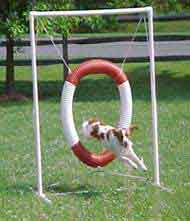 Agility is an event for dog and handler that can be poetry in motion or an embarrassing moment waiting to happen. It's a timed event over a variety of items, some standard to each course and some optional. There are A-frames and tunnels, and dog walks and teeters, weave poles, and all manner of jumps that can be decorated in the strangest ways. I saw jump standards that were hung with crabs, fish, flags, and flowers. I must admit, they would have given me pause; however, the dogs didn't seem to much care.
Agility is an event for dog and handler that can be poetry in motion or an embarrassing moment waiting to happen. It's a timed event over a variety of items, some standard to each course and some optional. There are A-frames and tunnels, and dog walks and teeters, weave poles, and all manner of jumps that can be decorated in the strangest ways. I saw jump standards that were hung with crabs, fish, flags, and flowers. I must admit, they would have given me pause; however, the dogs didn't seem to much care. 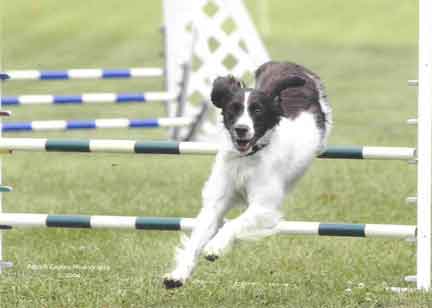 Wrong! You are dealing with a living, breathing four-legged power ball shoe can run the course as nature intended, clean and fast or bounce around like a pinball smacking soundly up against the TILT cushions. And both runs can and will be accomplished by the same dog at the some time. Factor in the handler who is trying to run this course as well, usually in under a minute and is in charge of remembering the pattern.
Wrong! You are dealing with a living, breathing four-legged power ball shoe can run the course as nature intended, clean and fast or bounce around like a pinball smacking soundly up against the TILT cushions. And both runs can and will be accomplished by the same dog at the some time. Factor in the handler who is trying to run this course as well, usually in under a minute and is in charge of remembering the pattern.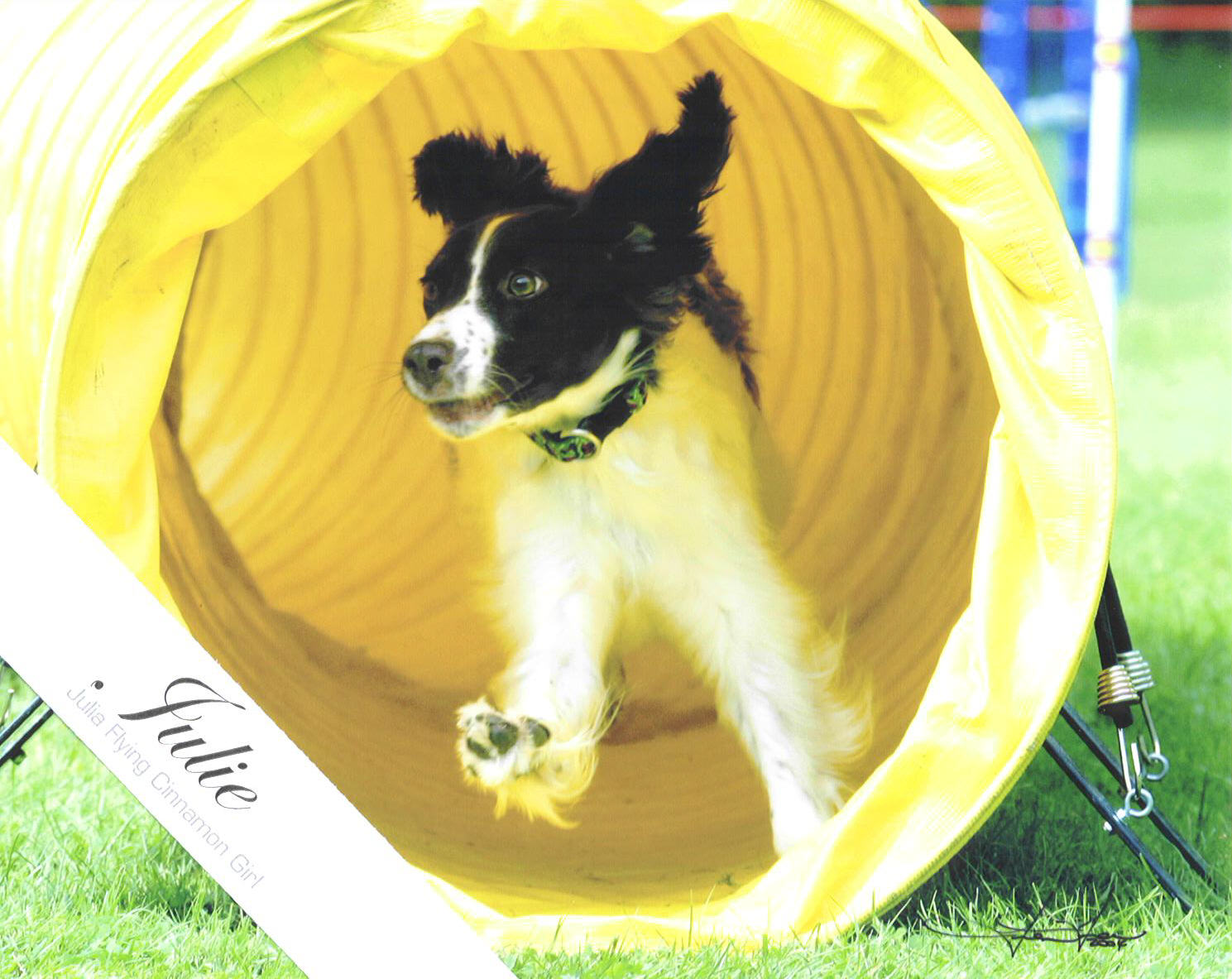 Wrong! You are dealing with a living, breathing four-legged power ball shoe can run
the course as nature intended, clean and fast or bounce around like a pinball smacking soundly up against the TILT cushions. And both runs can and will be accomplished by the same dog at the some time. Factor in the handler who is trying to run this course as well, usually in under a minute and is in charge of remembering the pattern.
Wrong! You are dealing with a living, breathing four-legged power ball shoe can run
the course as nature intended, clean and fast or bounce around like a pinball smacking soundly up against the TILT cushions. And both runs can and will be accomplished by the same dog at the some time. Factor in the handler who is trying to run this course as well, usually in under a minute and is in charge of remembering the pattern.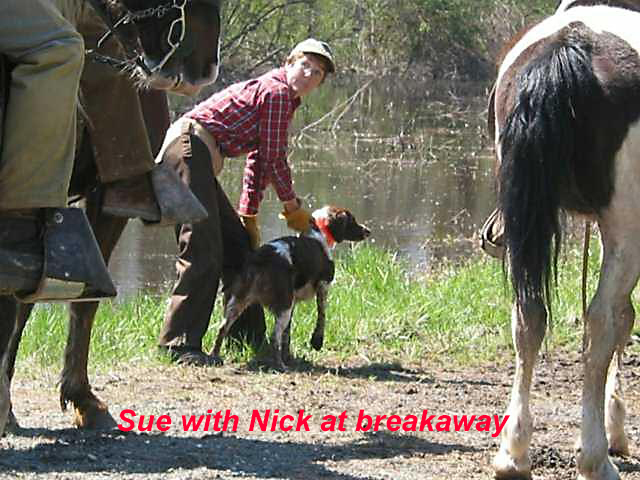 Brittany trials, licensed by the American Kennel Club, are held in almost all of the fifty states. Most of these licensed clubs normally holds one trial in the spring and another in the fall. Information about the time and location of the trials may be obtained from club secretaries whose names are listed in the American Brittany magazine.
Brittany trials, licensed by the American Kennel Club, are held in almost all of the fifty states. Most of these licensed clubs normally holds one trial in the spring and another in the fall. Information about the time and location of the trials may be obtained from club secretaries whose names are listed in the American Brittany magazine. 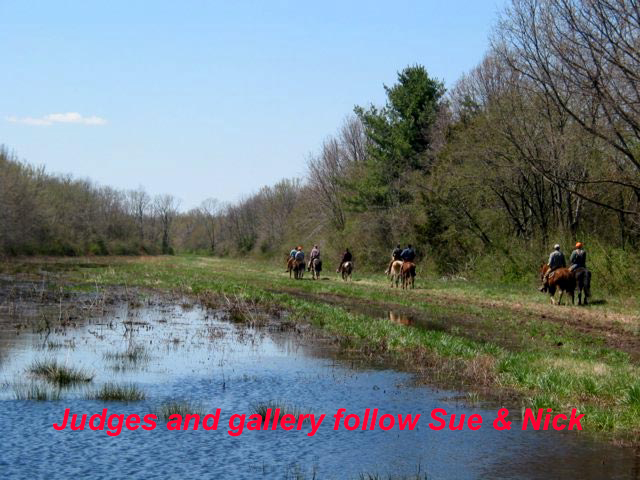 Entries for trials must be made on official entry forms. Entries usually close sometime during the week before the trial. Trials usually start early Saturday morning and end late Sunday, utilizing all the daylight hours. The premium list that you get from the secretary of the club giving the trial will have all the details - what stakes are being run, when they start, etc. If you intend to run your puppy and the premium list states that puppies will be fired over, you should equip yourself with a blank pistol to fire blank cartridges - or make arrangements to borrow one from one of the other competitors. Don't get a regular pistol for this; too many states have rigid laws forbidding carrying pistols in your vehicle. Firing over dogs is mandatory in all other stakes. You will find that horseback handling is allowable in most stakes. If you prefer to walk and handle your dog, you may do so. The rules say the horseback handler does not determine the pace. Usually the judge tries to set a pace, which is equitable for everybody.
Entries for trials must be made on official entry forms. Entries usually close sometime during the week before the trial. Trials usually start early Saturday morning and end late Sunday, utilizing all the daylight hours. The premium list that you get from the secretary of the club giving the trial will have all the details - what stakes are being run, when they start, etc. If you intend to run your puppy and the premium list states that puppies will be fired over, you should equip yourself with a blank pistol to fire blank cartridges - or make arrangements to borrow one from one of the other competitors. Don't get a regular pistol for this; too many states have rigid laws forbidding carrying pistols in your vehicle. Firing over dogs is mandatory in all other stakes. You will find that horseback handling is allowable in most stakes. If you prefer to walk and handle your dog, you may do so. The rules say the horseback handler does not determine the pace. Usually the judge tries to set a pace, which is equitable for everybody.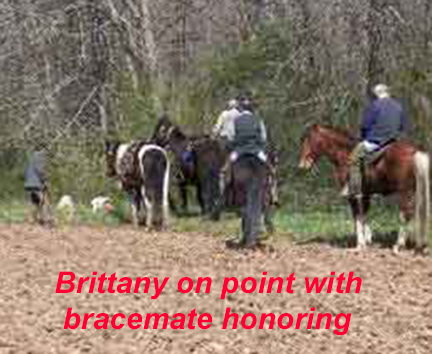 A Gun Dog must give a finished performance and must be under its handler's control at all times. It must handle kindly, with a minimum of noise and hacking by the handler. A Gun Dog must show a keen desire to hunt, must have a bold and attractive style of running, and must demonstrate not only intelligence in quartering and in seeking objectives but also the ability to find game. It must cover adequate ground but never range out of sight for a length of time that would detract from its usefulness as a practical hunting dog. The dog must locate game, must point staunchly, and must be steady to wing and shot. A dog that does not point cannot be placed. At least 30 minutes shall be allowed for each stake.
A Gun Dog must give a finished performance and must be under its handler's control at all times. It must handle kindly, with a minimum of noise and hacking by the handler. A Gun Dog must show a keen desire to hunt, must have a bold and attractive style of running, and must demonstrate not only intelligence in quartering and in seeking objectives but also the ability to find game. It must cover adequate ground but never range out of sight for a length of time that would detract from its usefulness as a practical hunting dog. The dog must locate game, must point staunchly, and must be steady to wing and shot. A dog that does not point cannot be placed. At least 30 minutes shall be allowed for each stake.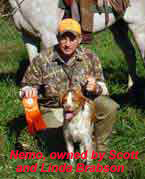 The adult stakes may be either Open or Amateur, the professional handlers, (one who trains and campaign dogs as an occupation) dominate the Open stakes and it takes an advanced amateur to win first place in this type of competition. The Amateur stake is open to any person who has not taken money or other considerations for training field dogs. The designation refer to the handlers in the stakes, not the dogs, so you will likely run into the same dogs in either stake, but the performance of some of the professionally trained dogs may be totally different with their amateur owner/handlers. In these adult stakes the dog's manners on birds are of prime importance. The dog must hold point while the handler flushes the bird and fires his blank pistol. It may not move until the handler gives it permission. In a small number of trials, where the birds are shot, the dog is expected to retrieve on command.
The adult stakes may be either Open or Amateur, the professional handlers, (one who trains and campaign dogs as an occupation) dominate the Open stakes and it takes an advanced amateur to win first place in this type of competition. The Amateur stake is open to any person who has not taken money or other considerations for training field dogs. The designation refer to the handlers in the stakes, not the dogs, so you will likely run into the same dogs in either stake, but the performance of some of the professionally trained dogs may be totally different with their amateur owner/handlers. In these adult stakes the dog's manners on birds are of prime importance. The dog must hold point while the handler flushes the bird and fires his blank pistol. It may not move until the handler gives it permission. In a small number of trials, where the birds are shot, the dog is expected to retrieve on command..jpg)
 I clean the inside of the ear flap and the inside of the ear by squirting ear cleaning solution into the ear canal, then massaging the base of the ear. I then wipe with a cotton pad wetted with an ear cleansing solution made especially to dry quickly. Let the dog shake it's head and dry the ears again. Regular cleaning will control the brown waxy buildup that smells. [Ear cleaning supplies on right.]
I clean the inside of the ear flap and the inside of the ear by squirting ear cleaning solution into the ear canal, then massaging the base of the ear. I then wipe with a cotton pad wetted with an ear cleansing solution made especially to dry quickly. Let the dog shake it's head and dry the ears again. Regular cleaning will control the brown waxy buildup that smells. [Ear cleaning supplies on right.] All brushing and combing is done in the direction the hair grows. Once the dog is thoroughly dry, a use a Zoom-groom (pictured on the right), a flexible soft rubber devise with 20 to 30 cone-shaped teeth. It fits in the palm of the hand and removes the loose guard hairs. It is very soft so it doesn't poke or scratch the dog's skin. It is especially good on the bony areas like the leg and feet.
All brushing and combing is done in the direction the hair grows. Once the dog is thoroughly dry, a use a Zoom-groom (pictured on the right), a flexible soft rubber devise with 20 to 30 cone-shaped teeth. It fits in the palm of the hand and removes the loose guard hairs. It is very soft so it doesn't poke or scratch the dog's skin. It is especially good on the bony areas like the leg and feet.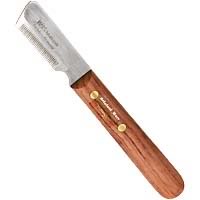 Start at the rear of the dog, combing a patch at a time, and work your way forward. The stripper comb removes dead hair, especially from the undercoat. The amount I can remove depends on the dog's coat. The thicker and woollier the coat, the more hair may remove.
Start at the rear of the dog, combing a patch at a time, and work your way forward. The stripper comb removes dead hair, especially from the undercoat. The amount I can remove depends on the dog's coat. The thicker and woollier the coat, the more hair may remove. .jpg)
_jpg.jpg)
_jpg.jpg)
_jpg.jpg)
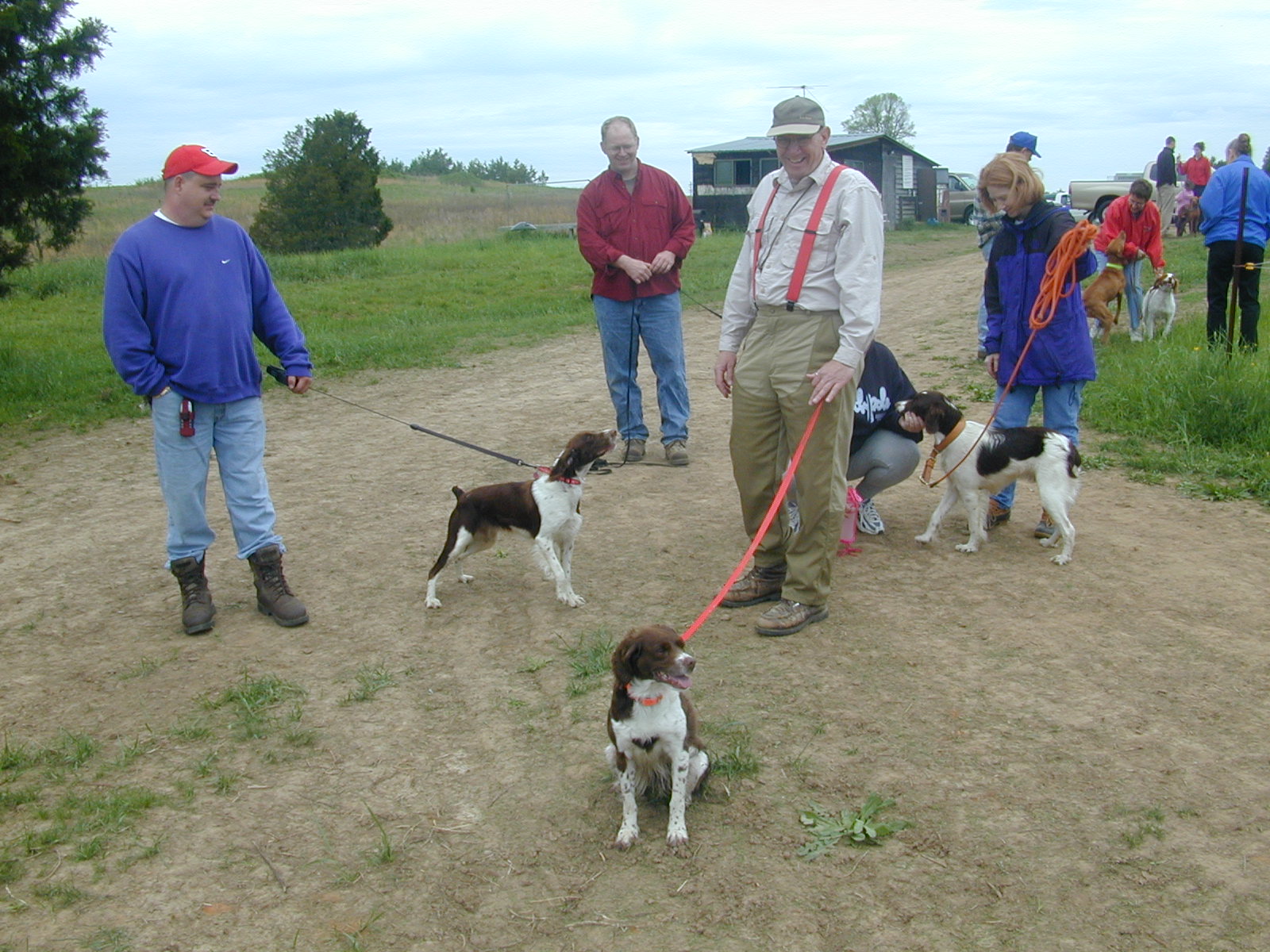
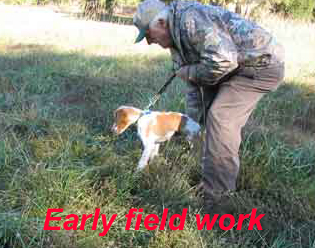 Club Fun Trials
Club Fun Trials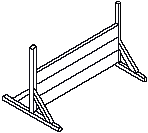 Why obedience training?
Why obedience training? 
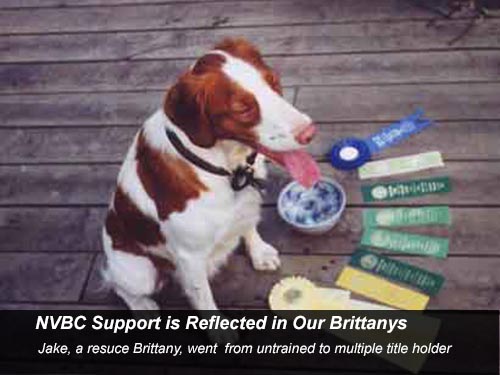 Obedience training also gives the dog owner the voice control necessary to prevent numerous potential tragedies. Not only will obedience training help your dog to become more responsive, it enables you to have immediate control over your dog's behavior; in an emergency situation, obedience training may save your dog's life. (
Obedience training also gives the dog owner the voice control necessary to prevent numerous potential tragedies. Not only will obedience training help your dog to become more responsive, it enables you to have immediate control over your dog's behavior; in an emergency situation, obedience training may save your dog's life. (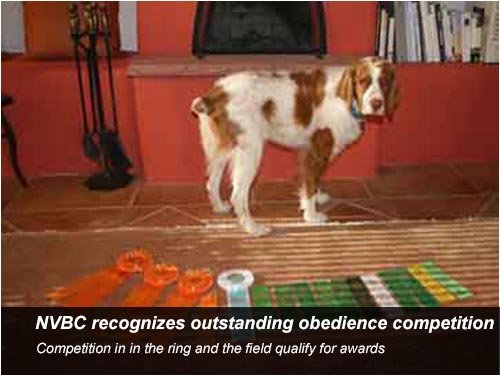 Be consistent with you commands, signals and body language. It takes a lot of the confusion out of the experience for your dog. There are a variety of training methods - read and talk to others and determine which works best for you and your dog. I do not reward with treats until after our work is complete. In obedience competition, you are not allowed to use treats so I thought it best not to add to Jake's confusion. Besides, being a Brittany he responds to praise and affection. As the exercises become more complex and difficult to master, I find that not using the word "no" has a more positive effect. When they are trying to figure out what you want, a negative command leads to more confusion and, certainly in Jake's case, nervousness and stress when he is trying to please but hears "no".
Be consistent with you commands, signals and body language. It takes a lot of the confusion out of the experience for your dog. There are a variety of training methods - read and talk to others and determine which works best for you and your dog. I do not reward with treats until after our work is complete. In obedience competition, you are not allowed to use treats so I thought it best not to add to Jake's confusion. Besides, being a Brittany he responds to praise and affection. As the exercises become more complex and difficult to master, I find that not using the word "no" has a more positive effect. When they are trying to figure out what you want, a negative command leads to more confusion and, certainly in Jake's case, nervousness and stress when he is trying to please but hears "no".